tow AUDI S8 2009 User Guide
[x] Cancel search | Manufacturer: AUDI, Model Year: 2009, Model line: S8, Model: AUDI S8 2009Pages: 408, PDF Size: 91.63 MB
Page 83 of 408
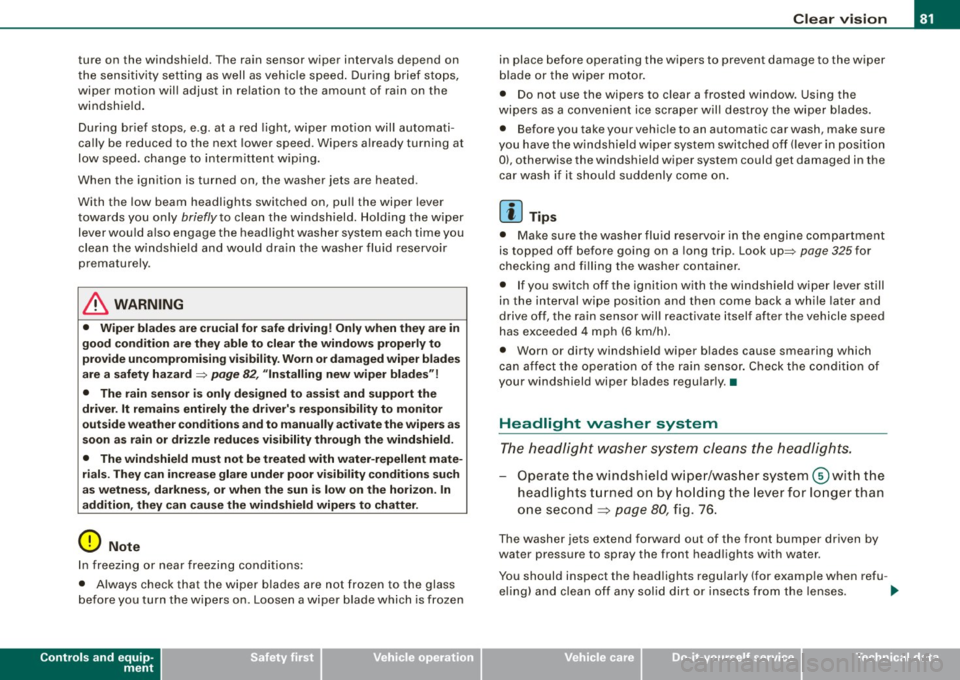
ture on the windshield. The rain sensor wiper intervals depend on
t he sensi tivi ty setting as well as vehic le speed . Dur ing brief s tops,
wiper motion wil l adjust in re lation to the amount of rain on the
windsh ield .
During br ief stops, e.g. at a red ligh t, wiper mot ion wil l automa ti
cal ly be reduced to the next lower speed . Wipers a lready turning at
low speed. cha nge to i ntermittent w ip ing.
When the ignition is turned on, the washer jets are heated .
With the low beam headlights switched on, p ull the wiper lever
towards you only
briefly t o clean the windshield. Ho lding the wiper
lever wou ld a lso engage the headlight washer system each time you
clean the w indsh ie ld and wou ld dra in the washer fluid reservoir
pr ematurely.
& WARNING
• Wiper blades are crucial for safe driving! Only when they are in
good condition are they able to clear the windows properly to
provide uncompromising visibilit y. Worn or damaged wiper blades
are a safety hazard
=> page 82 , "In stalling new wiper blade s"!
• The rain sensor is only designed to assist and support the
driver . It remains entirely the driver' s respon sibility to monitor
out side weather condit ions and to manually acti vate the wipers as
soon as rain or drizzle reduces visibility through the windshield.
• The windshield must not be treated with water-repellent mate
rial s. They can increa se glare under poor visibility conditions such
as wetness , darkness , or when the sun is low on the horizon. In
addition , they can cau se the wind shield wipers to chatter.
0 Note
In freezi ng or near freezing conditions:
• Always check that the wiper blades are not frozen to the glass
be fore you turn the w ipe rs on. Loose n a wiper b lade wh ich is fro zen
Controls and equip
ment
Cl ea r vision
in place before operating the wipers to prevent damage to the wiper
blade or the wiper motor.
• Do not use the wipers to clear a frosted window. Using the
wipers as a convenient ice scraper will des troy the wiper blades .
• Before you take your vehic le to an automatic car wash, make sure
you have the w indshield w iper system switched o ff (lever in p ositi on
Ol, otherwise the windshield wiper system could get damaged in the
car was h if it should suddenly co me on .
[ i ] Tips
• Make sure th e washer fluid reservoir in the engin e compart men t
is topped off before going on a long trip . Look up=>
page 325 for
check ing and fi lling t he washer conta iner.
• I f you switch off the ignition with the windshield wiper lever still
in the inte rval wi pe positio n and t hen come ba ck a while la ter and
drive off, the rain sensor will reactivate itself after the vehicle speed
has exceeded
4 mph (6 km/h) .
• Worn or dirty windshie ld wiper b lades cause smearing which
can aff ect t he opera tion of the rai n senso r. Check the c ondi tion of
your windshield wiper b lades regu lar ly . •
Headlight washer system
The hea dligh t washer s ys tem cle ans the he adlig hts.
Opera te the win dshi eld w iper/was her sy stem @wit h th e
h eadl igh ts t urned o n by ho ld in g the lev er fo r lo nge r than
one s eco nd
~ page 80, fig. 76 .
The washer je ts extend forward out of the fron t bumper driven by
water pressure to spray the front head lights with water .
You should inspect the head lights regu lar ly (for examp le when refu -
e ling) a nd c lean o ff any solid dirt or insects from the lenses. _,.
I • •
Page 94 of 408
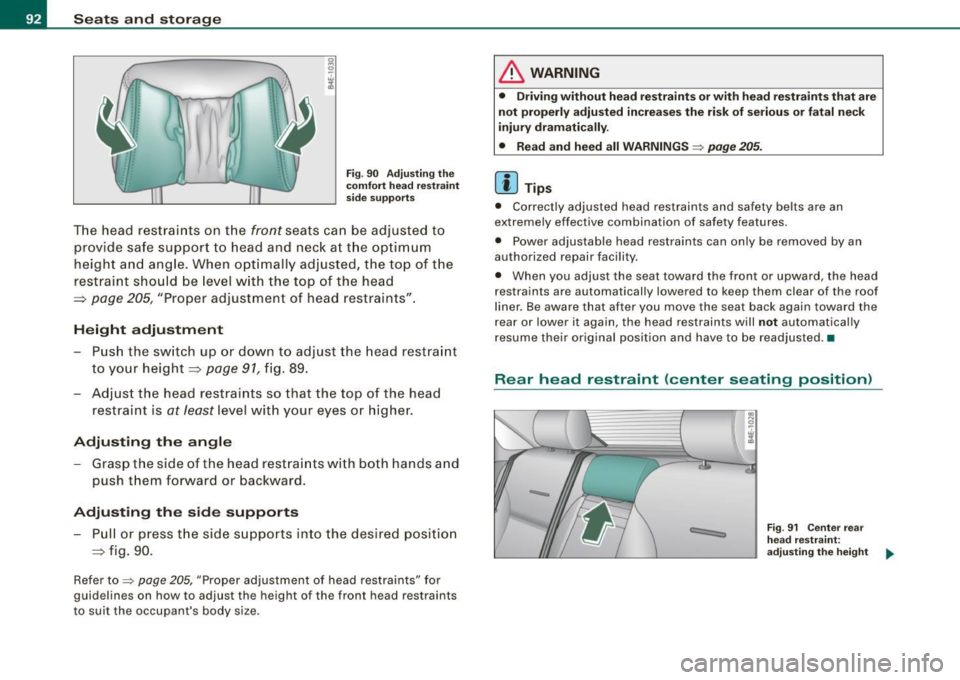
Seats and storage
Fig. 90 Adjusting the
comfort head restraint
side supports
The head restraints on the front seats can be adjusted to
provide safe support to head and neck at the optimum
height and angle. When optimally adjusted, the top of the
restraint should be level with the top of the head
=:> page 205, "Proper adjustment of head restraints".
Height adjustment
- Push the switch up or down to adjust the head restraint
to your height=:,
page 91, fig. 89.
- Adjust the head restraints so that the top of the head
restraint is
at least level with your eyes or higher.
Adjusting the angle Grasp the side of the head restraints with both hands and
push them forward or backward.
Adjusting the side supports - Pull or press the side supports into the desired position
=:, fig. 90.
Refer to=> page 205, "Proper adjustment of head restraints" for
guidelines on how to adjust the height of the front head restraints
to suit the occupant's body size.
& WARNING
• Driving without head restraints or with head restraints that are
not properly adjusted increases the risk of serious or fatal neck
injury dramatically.
• Read and heed all WARNINGS
:::> page 205.
[ i ] Tips
• Correctly adjusted head restraints and safety belts are an
extremely effective combination of safety features.
• Power adjustable head restraints can only be removed by an
authorized repair facility.
• When you adjust the seat toward the front or upward, the head
restraints are automatically lowered to keep them clear of the roof
liner . Be aware that after you move the seat back again toward the
rear or lower it again, the head restraints will not automatically
resume their original position and have to be readjusted. •
Rear head restraint (center seating position)
Fig. 91 Center rear
head restraint:
adjusting the height
Page 102 of 408
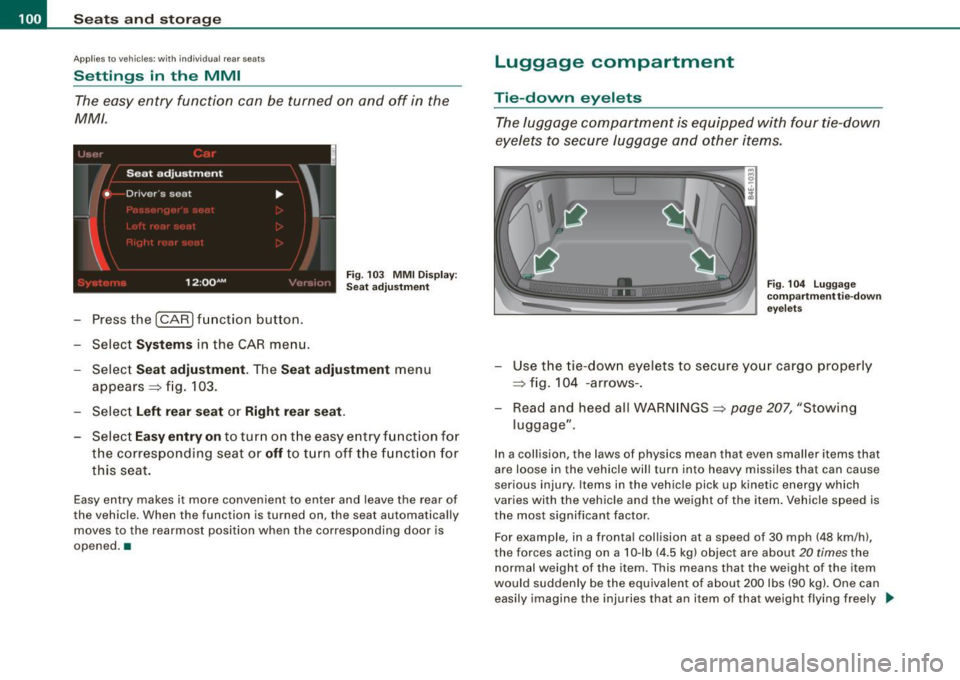
• ..__S_ e_a _ t_ s_ a_ n_ d_ s_t _o _r_ a-' g==- e ________________________________________________ _
Applies to ve hicles : w it h indi vid ual r ear se ats
Settings in the MMI
The easy entry function can be turned on and off in the
MM/.
J' ', ' r I
Seat adjustment
'
• Driver 's seat ...
I I
12 :QQ AM Fig . 103 MMI Disp lay:
Seat ad justment
- Press the I CAR I fun ction button .
- Selec t
Systems in the CAR menu.
Select
Seat adjustment . Th e Seat adju stment menu
appears => fig. 103.
Sele ct
Left r ear seat or Right r ear seat .
-Select Easy entry on to tur n on t he easy e ntry fu nction for
the c orresp onding seat or
off to t urn off t he fu nction for
this seat.
Easy entry makes it more convenient to enter and leave the rear of
the vehic le, When the function is turned on, the seat au tomatically
moves to the rearmost position when the corresponding door is
opened, •
Luggage compartment
Tie-down eyelets
The luggage compartment is equ ip p ed with f our tie -down
eyelets to secure luggage and other items.
Fig. 10 4 Lu ggage
co mp artm ent tie- dow n
e ye let s
- Use the tie-dow n eyelets to secure yo ur cargo properly
=> fig . 104 -arrows- .
- Read and heed all WAR NINGS=>
page 207, "Stowing
luggage".
In a collision , the laws of physics mean that even smaller items that
are loose in the vehicle will turn into heavy missiles that can cause
serious injury. Items in the vehicle pick up kinetic energy which
varies with the vehic le and the weight of the item . Vehicle speed is
the most significant factor.
For example , in a frontal collision at a speed of 30 mph (48 km /h) ,
the forces acting on a 10-lb (4 .5 kg) object are abou t
20 times the
normal weight of the item . This means that the weight of the item
would suddenly be the equivalent of about 200 lbs (90 kg). One can
easily imagine the injuries that an i tem of that weight flying free ly
I),
Page 104 of 408
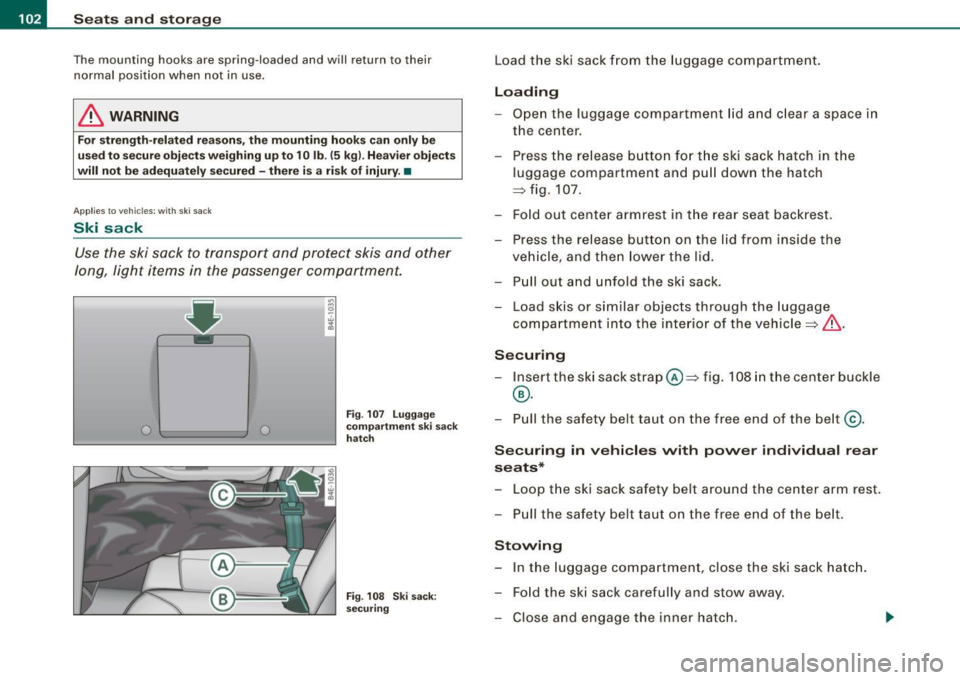
• ..__S_ e_ a_t _s _ a_n _d_ s_ t_ o _ r_ a_ g=- e ______________________________________________ _
The mounting hooks are spring-loaded and will return to their
normal position when not in use.
& WARNING
For strength-related reasons, the mounting hooks can only be
used to secure objects weighing up to 10 lb .
15 kgl. Heavier objects
will not be adequately secured -there is a risk of injury. •
Applies to vehi cles : wi th sk i sa ck
Ski sack
Use the ski sack to transport and protect skis and other
long, light items in the passenger compartment.
O •----0
Fig . 107 Luggage
compartment ski sack
hatch
Fig . 108 Ski sack:
securing
Load the ski sack from the luggage compartment.
Loading
- Open the luggage compartment lid and clear a space in
the center.
- Press the release button for the ski sack hatch in the
luggage compartment and pull down the hatch
~ fig. 107.
- Fold out center armrest in the rear seat backrest.
- Press the release button on the lid from inside the
vehicle, and then lower the lid.
- Pull out and unfold the ski sack.
- Load skis or similar objects through the luggage
compartment into the interior of the vehicle~& .
Securing
- Insert the ski sack strap@~ fig. 108 in the center buckle
®·
- Pull the safety belt taut on the free end of the belt@.
Securing in vehicles with power individual rear
seats*
Loop the ski sack safety belt around the center arm rest.
- Pull the safety belt taut on the free end of the belt .
Stowing
- In the luggage compartment, close the ski sack hatch.
- Fold the ski sack carefully and stow away.
- Close and engage the inner hatch.
Page 105 of 408

__________________________________________________ S_ e_ a_t _s _ a_n_ d_ s_ t_ o _r_a ..;:g::... e __ _
& WARNING
• The ski sack is intended only for the transportation of ski s and
other light objects . To reduce the risk of serious per sonal in jury,
neve r tran sport heavy or pointed objects in the ski sa ck.
• When braking rapidly or during an accident , the load could be
d is pl ac ed and cau se inju ry to o ccupants .
• Sharp edges on the load mu st be covered for protection.
Always f asten the belt t ightly around th e sa ck and it s contents
=> pag e 102 , fig. 108.
[ i J Tips
Never stow the ski sack away when i t is sti ll wet or damp (for
examp le, snow me lting from skis) . Allow it to dry completely before
stowing it away. •
Roof rack
First things first
A roof rack can be fitted to carry addi tio nal luggage on
the roof.
- Always read and follow the i nstructions provided by the
roof rac k manufacture r w hen t he roof rack system must
be installed.
I f a roof rack or similar luggage carrying equipment is to be
insta lled, please note the following:
• To enhance the vehicle's streaml ined design, rain gu tters have
been molded into the roof. It is not possible to use norma l roof
racks . Only instal l a roof rack sp ecifically designed f or your mo del
A8. Contact the nearest Audi dea ler for information on approved
m odula r roof racks for your veh icle .
Controls and equip
ment
• T hese approved roof racks are the basis for a comp lete roof rack
sys tem . Add itio nal attachments for the basic roof rack are neces
sary to safe ly transport luggage, bicycles, surf boards, skis or smal l
boats. All necessary hardware fo r these systems is available at your
authorized Audi dea ler.
• We reco mmend t hat you keep the installation i nstructi ons for
your roof rack system together with your Owner's literature in the
vehicle .
When should the ro of r ac k be remo ved ?
• Before g oing th rough an a uto matic car wash (it is bes t to ask the
car wash operator for advice)
• When not i n use, to reduce fue l consumption, wind noise and to
guard against theft.
& WARNING
• Use of an unapproved roof r ack or in corre ct mounting of an
a pp roved roof r ack can c ause the roof rack or the ite ms attached
to it to fall off the roof onto the road .
• Obje cts falling from the roof of a veh icle c an c ause a cras h and
personal inj ury .
• Onl y mount the sy stem between the marking s shown in
=> page 104 , fig. 109.
• The roof ra ck sy stem must be installed e xa ctly a ccording to the
instruction s provided .
0 Note
• Your vehicle warranty does not c over any damages t o the vehicle
caused by using roof racks or mounting structures not approved by
Audi for your vehicle. The same applies to damage resulting from
incorrect roof rack installation.
• Always check t he r oof rack m ount ings and hardware before eac h
trip and during a trip to make sure everything is securely tightened . .,,
I • •
Page 113 of 408

Seats and storage 1111
-----------------=-----'
Compartments in the door trim panels
Fig. 121 Storage
compartment in the
door panel
- To store items, tilt the compartment open=:> fig. 121.
& WARNING
Read and follow all WARNINGS ~ page 240, "Important safety
instructions on the side airbag system" .•
Ap plies to ve hicl es: with compartments in the rea r doo rs
Storage compartments in the rear doors
Con tro ls and eq uip
ment
Fig . 122 Open storage
compartment Fig.
123 Inserting
storage compartment
The storage compartment is suitable for holding small
objects, such as eye glasses.
Opening
-To open, touch the compartment at the front edge
=> fig. 122.
Removing and inserting storage compartment
- Open the storage compartment.
- Grasp the sides of the storage compartment with both
hands and pull it straight out toward you.
- To insert the storage compartment again, hold it at a
slight angle and push the lower part into the retainer
until it latches =:> fig. 123.
- Close the storage compartment .•
Vehicle care I I irechnical data
Page 132 of 408
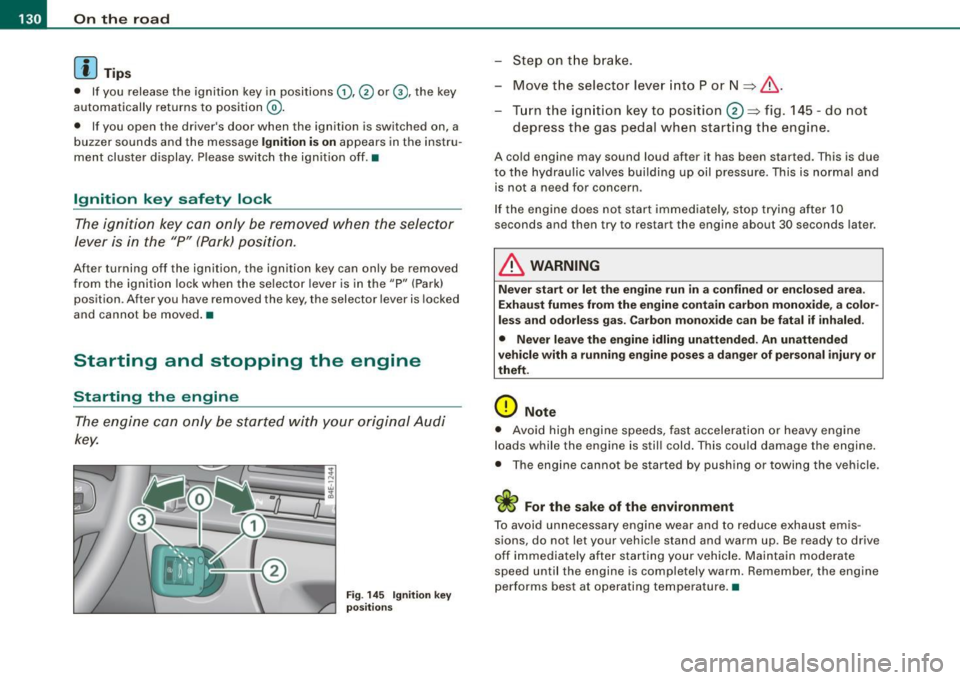
• ..__O_ n_ t_h _ e_ r_ o_ a_ d ____________________________________________________ _
[ i J Tip s
• If you release the ignition key in positions G) , @ or G), the key
automat ically returns to pos ition @.
• If you open the driver 's door when the ignition is switched on , a
buzzer sounds and the message
Ignition i s on appears in the instru
ment cluster display. Please switch the ignition off .•
Ignition key safety lock
The igni tion key can only be remove d when the selector
lever is in the "P" (Park) posi tion.
After turning off the ignition , the igni tion key can only be removed
from the ignition lock when the selector lever is in the "P" (Park)
position . Af ter you have removed the key, the selector lever is locked
and cannot be moved .•
Starting and stopping the engine
Starting the engine
The engine ca n only be started with your original Audi
key.
Fig. 145 Ignitio n ke y
po sitions
Ste p on the brake.
- Move t he selector lever into P or N
~ &.
Turn the ign ition key to position 0 ~ fig . 145 -do not
depress the gas pedal when s tarting the engine .
A cold engine may sound loud after it has been started . This is due
to the hydrau lic valves building up oil pressure. This is normal and
is not a need fo r concern .
I f the engine does not start immediately, stop t rying after 10
seconds and then try to restart the engine about 30 seconds later .
& WARNING
Never sta rt or let the engine run in a confined or en clo sed are a.
Exhaust fumes from the engine contain carbon monoxide, a color
less and odorle ss gas. Carbon mono xide can be fatal if inhaled.
• Never leave the engine idling unattended. An unattended
vehicle with a running engine po ses a d ange r of person al injury or
theft.
0 Note
• Avoid high e ngine speeds, fast acceleration or heavy eng ine
loads while the engine is still cold. This could damage the engine.
• The eng ine cannot be s tarted by push ing or towi ng the vehicle.
c£> For the sake of the environment
To avoid unnecessary engine wear and to reduce exhaust emis
sions, do not let your vehic le stand and warm up. Be ready to drive
off im mediately after starting your vehicle . Maintain moderate
speed until the engine is completely warm . Remember , the engine
performs best at operating temperature. •
Page 137 of 408

On the road -
----------------
Parking
To prevent a parked vehicle from rolling away, there are a
few things you should do.
When you park your vehicle , do the following
- Stop the vehicle using the brake peda l.
- Pull the switch to app ly th e electromechanical park ing
brake .
- Move t he selector lever into the
P positio n ~ &-
- Switch off the engine and remove the ignitio n key f rom
the ignition loc k.
When you park your vehicle on hills , do the
following
- Stop the vehicle using the brake peda l.
- Pull the switch to app ly th e electromechanical par king
brake.
- If you are parkin g headed
downhill , turn t he fro nt whee ls
toward the curb.
- If you are parking headed
uphill , turn t he front w heels
awayfrom the curb.
- Move the se lector lever into the
P position.
- Sw itch off the engine and rem ove the ignitio n key f rom
the ign ition lock.
& WARNING
Thi s is how you can reduce the r isk of injury when l eav ing your
v ehicle.
Controls and equip
ment
& WARN ING (c ontinued )
• Neve r p ark the vehi cle wh ere it c an come in cont act with dry
gra ss, s pilled fuel or any oth er fl amm able m ater ials.
• Wh en p arking on hill s, always turn the w hee ls s o that the front
wheel s will fir st roll into the cu rb , if the veh icle should start to roll.
• Never allo w anyone -e spe ciall y small ch ildren -to r em ain in the
vehi cle when it i s lo cked . Lo cked doors make it more diffi cult fo r
r e s cuers to acce ss the pa ssenger compartment in the event of an
emergen cy. Danger t o life!
• Never le ave chi ldren un supervi sed in the vehicle . Children
c ould release the p arking brake or mo ve the gear shift le ve r o ut of
g ear. The vehicle could start to roll away and cau se an a ccident.
• No matt er w hat the se a son i s, the temper atu re in a pa rked
vehicle can rea ch d angerou s levels.
0 Note
• Please exe rcise care when you park your vehicle in pa rking areas
with parking barriers or curbs . Parking barriers and curbs vary in
height and cou ld damage your bumper and re lated components as
the front of your vehicle moves over a barrier or curb that is too high, as you park or as you back out of a parking spot . In order to be
sure that no such damage can occur , you may w ish to stop short of
having the front tires of your car touch the parking barrier or curb.
• Please also exercise exceptional care when you drive up or down
steep ramps or drive over curbs or other obstacles, for which the
vehicle is not designed, because components of the vehicle close to
the ground, such as bumper covers, spoilers and suspension and exhaust system components, may become damaged. •
I • •
Page 140 of 408

• .___O_ n_ t_h _e _ r_o _a_ d __________________________________________________ _
& WARNING (continued)
• Please note that inadvertently "resting" your foot on the accel
erator pedal causes the cruise control not to brake . This is because
the cruise control is overridden by the driver's acceleration.
[ i J Tips
The brake lights illuminate as soon as the brakes decelerate
automatically. •
Changing speed
-Press lever in the 0 or O direction => page 137, fig. 149
to increase or decrease your speed.
- Release the lever to save that speed.
Change speed in increments of 1 mph (1 km/h) by lightly pressing
the lever . If you keep the lever pressed down, you will alter your
speed in 5 mph (10 km/h) increments.
You can also press the accelerator pedal down to increase your
speed, e.g . if you want to pass someone. The speed you saved
earlier will resume as soon as you release the accelerator pedal.
If, however, you exceed your saved speed by 5 mph (10 km/h) for
longer than 5 minutes, the cruise control will turn off temporarily.
The green symbol in the display=>
page 137, fig. 150 is rep laced
with a white symbol. The saved speed remains the same. •
Presetting your speed
You can preset your desired speed while the vehicle is not
moving.
- Turn on the ignition. -
Pull lever into position
G) => page 137, fig. 149.
- Press the lever in the
0 or O direction to increase or
decrease your speed.
- Release the lever to save that speed.
This function makes it possible, for example, to save the speed you
want before driving on the highway. Once on the highway, activate
the cruise control by pulling the lever toward
(D. •
Switching the system off
Temporary deactivation
- Press the brake pedal, or
- Press the lever into position
0 (not clicked into place)
=> page 137 , fig. 149, or
- Drive for longer than 5 minutes at more than 5 mph
(10 km/h) above the stored speed.
Switching off completely
-Press lever into position 0 (clicked into place), or
- Switch the ignition off.
The system retains the saved speed if you deactivate the cruise
control temporarily . To resume the saved speed, release the brake
pedal and pull the lever to position
(D .
Switching the ignition off erases the saved speed.
& WARNING
You should only return to the saved speed if it is not too fast for
the current traffic conditions -risk of an accident! •
Page 141 of 408

__________________________________________ ...;A~d~a~p~t~iv~e~C~ru~is~e~C:_:o~n~t!..ro~I _J __
Adaptive Cruise Control
Speed and distance control system
Applies to vehic les : with Adaptive C ruise Cont rol
Description
The Adaptive Cruise Control driver assistance program is
a combined speed and distance control system.
Fig. 151 Front
bumper: Position of
radar sensor
Adaptive Cruise Control can help make driving more relaxed and
less tiring, particularly during long trips on interstates or other
highways that are generally straight .
Set ACC to maintain a constant, legal travel speed between 20 and
95 mph (30 -150 km/h) that is appropriate for prevailing traffic
conditions. Select a following distance to the vehicle ahead and ACC
will adjust your speed to maintain that distance .
Adaptive Cruise Contro l has technical limitations that you must
know, so please read this section carefully, understand how the
system works and use it proper ly at all times .
How does it work?
You can operate the Adaptive Cruise Control using the lever on the
steering wheel column =>
page 142, "How is the speed stored?" and
=>
page 144, "How is the distance set?" .
Contro ls and eq uip
ment
Driver information
Important information is brought up in the speedometer and in the
instrument cluster display as the vehicle is being driven
=> page 146, "Driver information" .
What is important for you to know
There are limits to what Adaptive Cruise Control can do as the
vehicle is being driven =>
page 150, "System limitations" .
& WARNING
Improper use of the Adaptive Cruise Control can cause collisions,
other accidents and serious personal injury.
• Always remember that the Adaptive Cruise Control has limits -
it will not slow the vehicle down or maintain the set distance
when you drive towards an obstacle or something on or near the
road that is not moving, such as vehicles stopped in a traffic jam,
a stalled or disabled vehicle.
• Always remember that the Adaptive Cruise Control cannot
detect a vehicle that is driving towards you in your traffic lane and
that it cannot detect narrow vehicles such as motorcycles and
bicycles .
• Never drive at speeds that are too fast for traffic, road and
weather conditions .
• The Adaptive Cruise Control cannot slow or brake the vehicle
safely when you follow another vehicle too closely. Always
remember that the Adaptive Cruise Control has a braking power
that is only about 30% of the vehicle 's maximum braking ability.
Always be prepared to brake and take evasive action to avoid colli
sions and other accident situations.
• Never allow the closing speed between you and other vehicles
to be so high that the Adaptive Cruise Control may not be able to _,,,
Vehicle care I I irechnical data